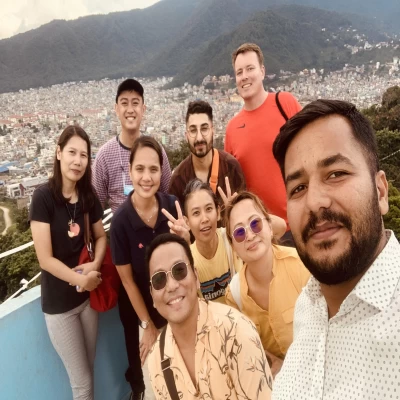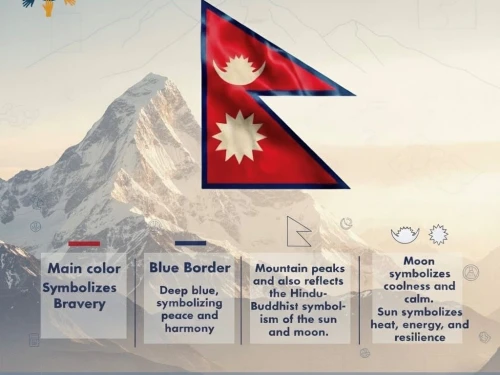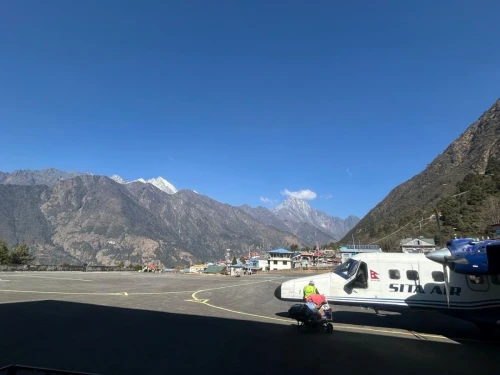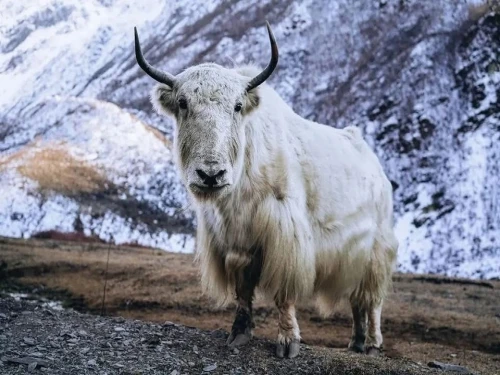How is the Khumbu Icefall Formed?
The largest glacier in Nepal, the Khumbu Glacier, produces the Khumbu Icefall through its gradual but steady downward flow. For your information, during periods of peak thawing, the central flow rate can reach up to 4 meters per day, with the Khumbu glacier moving between 0.9 and 1.2 meters per day.
The complicated internal flow dynamics of the glacier are demonstrated by the fact that it typically takes four to five years for the ice entering the icefall to move from the top to the base. Khumbu Icefall is an example of how small changes in nature can add up to a significant change and is a true work of nature.
Additionally, the deep crevasses, which are about 100 metres deep and 15 metres wide, open and close every day due to glacier shifts, posing serious risks to climbers. And the huge blocks of ice, called seracs, can collapse at any time and without warning, causing deadly avalanches.
The icefalls are actually the most hazardous part of any climbing route because, in contrast to rock or snow slopes, they are constantly moving and present hazards like crevasses and shifting seracs. And the Khumbu Icefall on Everest is no exception, making it one of the most unpredictable and dangerous sections of climbing.
Why is the Khumbu Icefall so Dangerous?
There is a good reason why the Khumbu Icefall is known as the most unsafe section of the mountain. Since the Khumbu Icefall is the most dangerous climb on Everest, dozens of climbers have died there over the years, the majority of whom were Sherpa guides.
The Khumbu Icefall is extremely dangerous for the following reasons:
Unstable Ice Towers (Seracs)
Huge blocks of ice loom like skyscrapers, poised to collapse at any moment. They frequently cause avalanches that thunder down the slope, and even the most seasoned climbers are unable to predict when one will crash down.
Deep Crevasses
There are numerous wide fissures in the Icefall, some of which are more than 100 metres deep. Many are concealed beneath brittle snow bridges, ready to collapse beneath feet. Here, one mistake could be lethal.
Avalanche Threat
There is always a risk of avalanches. At any time, snow or ice may fall from the sky, occasionally due to the glacier's own movement. In 2014, the Icefall experienced its deadliest single accident in its history when a huge avalanche of ice from Everest's West Shoulder swept through it, tragically killing 16 Nepali guides.
Thin Air & Extreme Cold
Every breath is a struggle at 5,500–5,800m. Temperatures remain well below freezing, icy winds can bite, and altitude sickness or frostbite can occur in a matter of minutes. A minor delay or a moment of exhaustion can make a risky crossing fatal.
How to Cross the Khumbu Icefall Safely?
Although there are no set rules or regulations to guarantee complete safety when crossing the Khumbu Icefall, the following list of methods has been compiled from firsthand experience to help you navigate the region's constantly shifting and hazardous icefall:
- Sherpa “Icefall Doctors”: Local sherpa climbers and guides, known as the Icefall Doctors, enter the Khumbu Icefall first before climbers attempt it and before the climbing season officially begins. They inspect the entire area, identify the safest routes for the season, and then install the ropes, ladders, and other equipment required for a safe journey. The true heroes are these sherpas, who put their lives in danger to give other climbers an easier and safer route.
- Early Morning Crossings: Timing is crucial for this difficult section, just like it is for any other climbing or trekking. Entering the Icefall during the coldest times of the day is strongly advised. Because the ice is firm and less likely to collapse during these cold hours, the majority of climbers depart the base camp early in the morning, usually around three or four in the morning.
- Essential Gear: It's vital to have all the necessary equipment for this demanding climb and potentially fatal task, and to confirm that it's in operational condition before beginning. Safety and balance are provided by essential equipment such as helmets, carabiners, crampons, and harnesses.
- Using Ropes and Ladders: The Icefall has deep crevasses and unstable areas that require the use of ropes and ladders for a safe ascent. Ropes and ladders should be used with caution and good body control because even a minor error can have deadly consequences.
- Speed and Efficiency: Although it's best to take your time and avoid hurrying, experts advise limiting the amount of time you spend in the Khumbu Icefall because doing so lowers your exposure to potential risks.
- Team Coordination: Unity is one of the greatest strengths, as we all know, and this theory applies here since the climbers are expected to move in small groups for each other's safety and general support.
Major Tragedies in the Khumbu Icefall
The deadly reputation of the Khumbu Icefall did not appear overnight, and the decades of tragic events that have claimed 47 lives highlight how dangerous it is. These tragic events also highlight the fact that crossing this deadly Khumbu icefall is dangerous and cannot be completely avoided with experience or preparation.
Although this section contains a number of tragic deaths, the following are the most notable.
Japanese Expedition April 5, 1970 | Seracs Collapsed August 31, 1982 | Avalanche Disaster April 18, 2014 |
| As a group of Japanese climbers prepared to ascend Everest, a tragic incident occurred. Six Sherpa guides were mercilessly killed by an unexpected collapse of towering ice, demonstrating that even experienced climbers are powerless against it. In addition to demonstrating the vulnerability of the icefall's seracs, this incident established a sad precedent for upcoming Everest expeditions. | This tragic day brought to light the unpredictable nature of Khumbu Icefall once more when large seracs unexpectedly collapsed, killing several climbers and seriously injuring others. Three sherpas were killed, but many other climbers were severely injured. The unstable terrain made rescue efforts even more difficult. | This is among the deadliest incidents in the history of the Khumbu icefall and Mount Everest climbing. The route was swept by a huge avalanche of ice from Everest's west shoulder, killing 16 Nepali Sherpas who were there to set up the ropes and ladders for climbers. The entire climbing community around the world was shocked by this tragedy, which also raised awareness of the severe dangers that sherpas must endure throughout the year. |
Explore the Khumbu Icefall Without Risks
Despite its risks and difficulties, the Khumbu Icefall is unquestionably one of Everest's most magnificent sights. However, you don't have to put your life in danger to witness this captivating icefall.
You can observe this frozen wonder from a secure and convenient vantage point in a variety of ways. With more than ten years of experience in the Nepali travel industry and a team of knowledgeable Sherpa guides, Mount Glory Treks has expertly put together a number of Everest trek packages that allow you to see the Khumbu Icefall without taking any risks.
Everest Base Camp Trek
The classic EBC trek to the foot of Mount Everest and the Khumbu Icefall. This 5,364-meter hike gives you a front-row seat to the enormous ice seracs and the constantly moving glacier. Additionally, you can safely observe the dynamic movement of the icefall from EBC, and occasionally, you can even hear the distant rumble of shifting ice.
The package also includes a walk to Kala Patthar (5,555 m), which provides the best sunrise view of the Khumbu region, including neighbouring peaks and the Khumbu icefall snaking below.
EBC Helicopter Tour
Are you short on time and energy? Then this helicopter tour from Kathmandu to EBC to witness the Icefall is the perfect package for you. This luxury package will take you over the mountains in a short period of time and hover over the Khumbu Icefall itself.
With minimized risks and hassle of trekking through challenging routes of the Everest region, you can exclude all and comfortably reach EBC.
We offer additional trekking packages to Everest in addition to these travel packages, which increase the excitement of your journey while lowering the risks. Everest View Trek, Three Passes Trek, and Gokyo Lakes Trek are a few of the well-liked Everest alternative treks.
This package gives you access to undiscovered Everest region features that are typically not included in standard packages.
In Conclusion
You must now be familiar with the Khumbu Icefall and its dangers after reading this blog. This icefall is a deadly gateway to the Everest expedition, providing a glimpse of the dangers of Everest.
As we know, it's a place where climbers' skill and luck meet, and for sherpas, who must frequently finish for the safety of others, it's a high-stakes challenge. Ultimately, the Khumbu Icefall is merely a stepping stone to the deadly challenges of the Everest expedition.
And it's perfectly acceptable if you're not yet up to the challenges of the Everest expedition because, as we previously stated, there are a number of moderately difficult Everest treks, and once you get close, you can make a serious decision about whether you're up for the bigger challenges.
Trek to EBC, a luxury helicopter ride, or one of the many amazing alternative treks, allows you to enjoy the splendour and strength of the Khumbu Icefall without having to take the risk of actually walking on the glacier.
Frequently Asked Questions
1: What is the Khumbu Icefall?
The Khumbu Icefall is a huge, ever-changing glacier that forms a crucial portion of the South Col route.
2: Where is the Khumbu Icefall located?
It is located in the Khumbu region of Nepal and stretches from Camp I (approximately 6,065 m) to Everest Base Camp (approximately 5,364 m).
3: What makes the Khumbu Icefall dangerous?
It is one of the riskiest parts of the Everest climb because of the unstable ice towers (seracs), deep crevasses, and frequent avalanches.
4: How fast does the Khumbu Glacier move?
The glacier continuously reshapes the icefall by shifting by about 0.9 to 1.2 metres every day.
5: Can trekkers witness the Khumbu Icefall without climbing?
Yes, you can get breathtaking views of the Icefall while trekking to Kala Patthar or Everest Base Camp.
7: What is the best time to trek to Everest Base Camp?
The seasons with the most consistent weather are spring (March–May) and autumn (September–November).
8: Is a permit required to visit the Khumbu Icefall?
Trekkers must have a TIMS card for the Everest region and a permit for Sagarmatha National Park.
9: Does the Everest Base Camp trek allow trekkers to hire guides?
It is highly advised to hire certified guides for safety, navigation, and cultural understanding.
10: What are the main hazards in the Khumbu Icefall?
Significant hazards include deep crevasses, hidden snow bridges, avalanches, and collapsing seracs.
11: What safety measures are in place for climbers?
Ladders and fixed ropes are installed by Sherpa "Icefall Doctors," and climbers are encouraged to cross early in the morning.
12: Has there been a change to the Icefall climbing route?
Every season, the route is frequently modified to account for shifting ice and lower the risk of avalanches.
13:What is the Western Cwm?
On the south route of Everest, it is a level valley that leads climbers to Camp II above the Icefall.
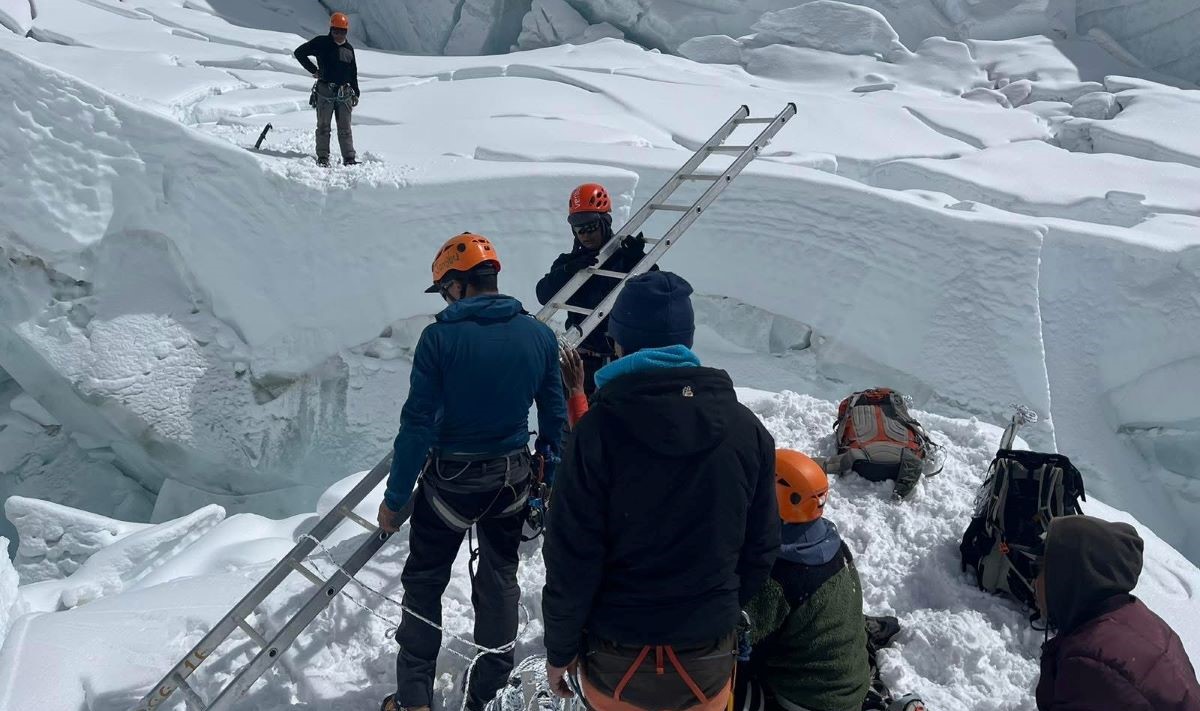




 4 reviews
4 reviews